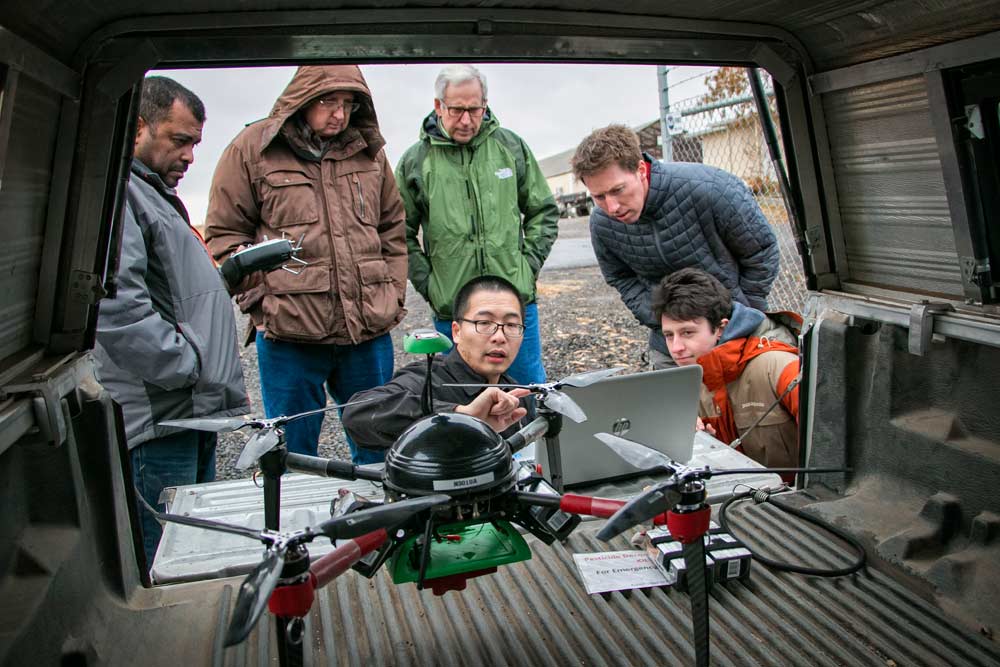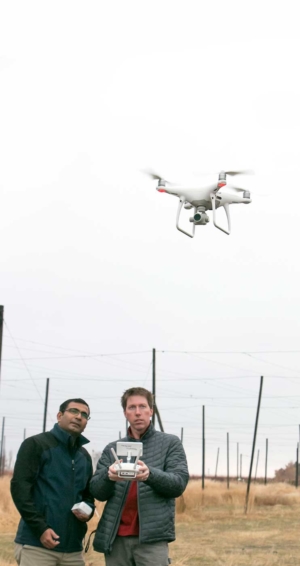
Chongyuan Zhang, center, demonstrates part of the drone preflight sequence during the first Washington State University agricultural drone workshop on November 9, 2017, in Prosser, Washington at WSU’s Center for Precision & Automated Agricultural Systems facility. (Ross Courtney/Good Fruit Grower)
Good Fruit Grower’s TJ Mullinax participated in Washington State University’s first ag drone workshop and offers these insights for growers considering “going drone.”
Let’s get the least important thing out of the way first. It doesn’t matter if you get to fly a fixed-wing remote control plane, helicopter, quadcopter, octocopter or even a blimp — it just sounds fun.
Modern drones, or Unmanned Aerial Vehicles as the Federal Aviation Administration calls them, have been taking off, and their popularity is increasing.
You may be thinking there’s untapped potential for using these relatively inexpensive tools at your farm. But before you consider testing the waters, here are a few things to consider before using drones for agricultural work. I put an emphasis on “work” — not just flying around taking nice photos for fun. Leave that to your marketing staff.
1. Develop a plan.
One of the top things before going drone is having a clear roadmap with achievable goals. It’s perfectly OK to buy a consumer UAV to learn to fly and photograph your crops, understand how to analyze and store the camera data, and sort out maintenance and potential staffing. Before you get serious though, you’ll need to make a plan for the long term.

Washington State University researcher Lav Khot, left, assists Good Fruit Grower digital producer TJ Mullinax, during the first Washington State University drone workshop in November 2017, in Prosser, Washington. (Ross Courtney/Good Fruit Grower)
Agricultural UAV work is a bit like starting a small research program because the technology is rapidly changing, methods are still trial and error, and your results may not have fixed values or outcomes.
If you can identify what you want to learn from the drone imagery and accept inconsistent results, then you’re about halfway to going drone.
If you’re not OK with inconsistent results from your own experimentation, then …
2. Find an agricultural service or contractor to fly and analyze the drone images.
If you don’t, you or someone on your staff will have to get licensed as an FAA UAV pilot, with small UAS rating, before your farm can legally operate UAVs.
While recreational fliers don’t need the license, if you’re flying drones for work, you’ll need the license along with drone registration.
Those are the first hurdles you’ll need to clear. The next big hurdle comes after you start flying and recording your crops with high-definition and multispectral cameras.
Today’s cameras record a lot of data, and future cameras will provide more. If you don’t have a plan for storing and interpreting that data, then your work may be wasted.
According to Washington State University researcher Lav Khot, photographing a single acre with a commercial multispectral camera mounted on a drone can create about a half a gigabyte of raw data — with the potential for much more depending on the setup.
Current drone-mounted sensors and cameras come with several challenges and limitations if not used properly, but they have the potential to improve the health and output of your farm.
If you are looking at starting a program, I recommend finding services or contractors who can help evaluate and prioritize your first steps.
Before going drone, make a plan, seek out others who’ve been successful and take it slow. The sky’s the limit; that is, of course, until the FAA and each state’s Department of Transportation lowers your operational ceiling. •
Websites and mobile apps:
FAA
- Know before you fly (for business/personal and public entities): http://knowbeforeyoufly.org
- FAA UAS web page (links to register drone, request flight waiver, become a drone pilot, Part 107 study test): https://www.faa.gov/uas/
- First time pilot requirements: https://www.faa.gov/uas/getting_started/part_107/remote_pilot_cert/#first
- Rules for drone operators (2017) : https://www.faa.gov/regulations_policies/rulemaking/media/021515_sUAS_Summary.pdf
Mobile apps
- Hover app – US and International (easy and quick checklist of on-site flight restrictions and weather issues. Has other useful tools such as flight log, etc. The app can download maps of locations and country maps if you are without cell coverage and operating with GPS data only.) http://www.hoverapp.io/
- B4Ufly app – US only (good for assessing flight restrictions, rules and warnings before you fly): https://www.faa.gov/uas/where_to_fly/b4ufly/
—by TJ Mullinax






Leave A Comment